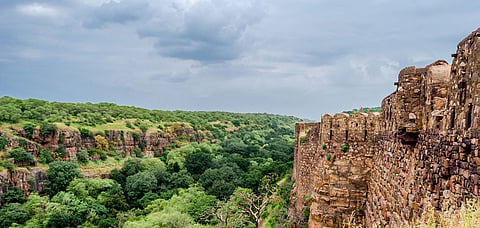
- Destinations
- Experiences
- Stay
- What's new
- Celebrating People
- Responsible Tourism
- CampaignsCampaigns
- Subscribe
- Buy Now

Nestled in Sawai Madhopur district of Southeastern Rajasthan lies the wildlife sanctuary known for its Bengal tigers, the Ranthambore National Park. Densely populated by the national animal of the country, its rich fauna means that hyenas, nilgais, langurs, and the Indian leopards also find home in this vast territory. Enclosed by the Banas River to the north and the Chambal River to its south, the national park is about 150km from Jaipur. Deriving its name from the monumental Ranthambore fortress that sits deep within, this wildlife destination is home to a diverse range of birds, reptiles, and tress.
The park consists of 10 zones, The first zones (1-5) form the core part of the park while the remaining zones are in the buffer area. Tiger sightings, for which the best time is between November and June, are common in the core zones. The tigers, having become used to human presence, aren't threatened and go about their business as usual. You should also keep an eye out for the Monitor Lizards, Snub-Nosed March Crocodiles, Nilgais, and the Indian Leopard,
There are two types of jungle safaris on offer at the Ranthambore National Park. The first one is the Canter Safari, an open-topped truck with 20 seats, which will take you through zones 1-6 but not 7-10 and happens to be three-and-a-half-hours long. The other option you have is the Jeep Safari, which is tad bit more expensive, but offers a more private experience. A trip in the Jeep means you can navigate through long narrow, winding roads increasing your probability of sighting more unique forms of wildlife.
The safaris can be booked online here (Rajasthan government website) 90 days in advance. It's a long and tedious process especially for foreigners whose cards may not be accepted. However, while booking online you have the option from choosing a safari in the core zones or other zones.
There are several other places that you should plan a trip to. Start off with the Ranthambore Fort, offering the best view of the national park. One of the historic forts in the country, hordes of langur roam the grounds here, so beware of them as they will attempt to steal your belongings and food. Interestingly, a Digambar Jain Temple, a mosque, and a dargah have been constructed within the confines of this marvellous fort.
Also lying inside the Ranthambore National Park are three lakes. The largest, Padam Talao gets its name from the large number of lotuses that it houses. Also, on its fringes, you'll find the Jogi Mahal providing with a breathtaking spot for photos. The Malik Talao, which happens to be the smallest of the lakes, is overly populated with Marsh Crocodiles. If you happen to be in love with reptiles, mark this place as a must visit on your bucket list. The last lake in the park is the Raj Bagh Talao of which Sambar Deers and Egrets are regular patrons. Additionally, this lake falls under the prime tiger spotting area.
Take a look at options for stay here.
Prices
Jeep Safari INR 897 for Indians, INR 1,637 for foreigners. For children under the age of five, it is free.
Canter Safari INR 562 for Indians and INR 1,302 for foreigners.
